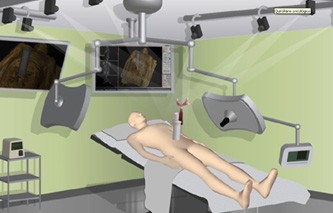GMV collaborates in the development of the world’s first cancer-operation room with navigator for the Hospital Gregorio Marañón

The Hospital Gregorio Marañón now boasts the world’s first ever cancer-operation room equipped with a navigator. This trailblazing system authorizes real-time interaction with the patient’s body and also with the radiotherapy applicator used to radiate the tumor site. This breakthrough will now be used for surgery of cancers treated with intraoperative radiotherapy, with the purpose of achieving greater precision and accuracy in the radiation of potentially cancerous tissues following excision of the tumor.
GMV has been one of the leading figures in the development of this groundbreaking image-guided system together with researchers of the Hospital Gregorio Marañón and the two universities Carlos III de Madrid and Complutense, within the framework of research projects funded by the Comunidad de Madrid (Regional Authority of Madrid) and the Ministerio de Economía y Competitividad (Ministry of Economics and Competitiveness).
The installation of this new equipment has involved a total restructuring of the operating room. The new operation room, reinforced for this kind of procedure, integrates high-definition screens of high diagnostic quality to display the patient’s image in 3-D, three video monitoring cameras and a cohort of eight infrared cameras for real-time navigation positioned in the area of the surgery that allows the surgeon to capture the movement of objects throughout the whole process.
Physicians will now have a 3-D illustration of the patient and the applicator that performs the radiation so that it can be guided into the patient through the high-definition screens set in the operating room. On the basis of the 3D representation, reconstructed from a previous scan, placement of the applicator over the tumor bed is monitored to ensure that only tissues with cancerous remnants or at risk of turning cancerous are radiated in each patient.
Dr. Felipe Calvo, head of the Oncology Department at Hospital Gregorio Marañón, points out that the radiance intraoperative radiotherapy simulator (developed and patented by GMV together with Marañón hospital researchers and practitioners) and this new navigator "will make it possible to cut treatment time thanks to the use of large single doses on a very well-defined tumor, protecting healthy tissue at the same time. Intraoperative radiotherapy does not compete with but instead complements chemotherapy and the administration of biological medicines”.
This system makes Hospital Gregorio Marañón an international benchmark in technological innovation and the application of research results to daily clinical practice.